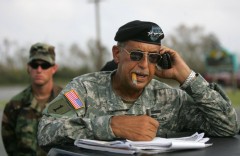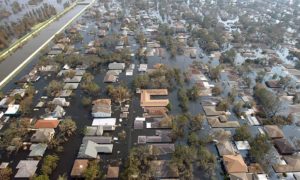Aug. 29 marks 10 years since Hurricane Katrina hit the Gulf Coast of the U.S., with the city of New Orleans bearing the brunt of the damage and catastrophe. Although the hurricane itself was a disaster brought about through an act of nature, another catastrophe resulted from human negligence, incompetence and willful neglect. At the center of the human toll were Black people — poor and forgotten with nowhere to run — who were victims of economic and racial discrimination and the most vulnerable casualties when Katrina hit.
A category 3 hurricane, the 400-mile-wide storm came with winds of 100-140 mph. It was the most expensive disaster, and one of the deadliest in U.S. history, with a death toll close to 2,000, and $108 billion in damage. Moreover, over 1 million people were displaced from the Gulf Coast, an unprecedented diaspora in American history. However, it did not have to be this way.
Granted, New Orleans was especially vulnerable, given that the crater-shaped city is completely surrounded by water, and although half of the city is above sea level, the average elevation is 6 feet below sea level. In the last century, the Army Corps of Engineers built a series of levees and seawalls to prevent the city from flooding. As the History Channel notes, while the levees along the Mississippi River were secure and strong, the levees built for Lake Pontchartrain, Lake Borgne and swamps and marshes to the east and west of the city were weak and unreliable and poorly maintained. Before the disaster that was Katrina struck, officials were concerned that these jerry-rigged levees, placed on top of sandy soil, would not withstand a massive hurricane. Meanwhile, the poorest neighborhoods existing below sea level — Black communities in particular — were at the greatest risk of flooding.
There were 53 levee breaches, leaving 80 percent of New Orleans submerged. This represented the most substantial civil engineering failure in U.S. history. As The Guardian noted, the lower Ninth Ward of the city became a symbol of the tragedy, with the catastrophic impact collapsing concrete floodwalls. While 80 to 90 percent of people were evacuated before the storm, the thousands upon thousands who remained were poor and had no transportation to leave the area.
There were stories of true human suffering, deprivation and degradation. Scenes of bloated bodies floating down flooded streets became a shameful embarrassment in the most resource-rich nation in the world. This, as 25,000 languished in the Louisiana Superdome. As the Los Angeles Times reported five years ago, “It was during Hurricane Katrina, and everybody who was nobody in New Orleans was there: elderly people so frail they could barely walk, mothers with sweaty babies on each arm, budget tourists whose hotels had closed, down-and-out citizens who didn’t have cars — people with no prayer of getting out of town and no shelter but the massive, 27-story stadium that became, for six awful days, a sweltering cesspool of human misery.” Six people died in the Superdome, in a 90-degree environment with blood-stained walls, in which children slept on urine-soaked cardboard. At least two people, including a child, were raped. The masses in the Superdome were subsequently relocated by Greyhound bus to the Houston Astrodome.
Prisoners were reportedly abandoned in their cells, with hundreds officially unaccounted for — a cruel form of punishment, and a death sentence, on top of their existing incarceration.
Reports of looting — which were understandable, given the gravity of the circumstances and the desperation people faced — led to overreaction, including the proliferation of white vigilante groups. On the city’s West Bank, police in Gretna, a white suburb, set up barricades on the Crescent City Connection, a federal bridge crossing the Mississippi River. With shotguns in the air, police stood at the border and refused the poor New Orleans residents entry to the other side.
In the aftermath of Hurricane Katrina, New Orleans was a venue for police misconduct and brutality. Perhaps the most glaring example was a Sept. 5, 2005, incident on the Danziger Bridge. In 2011, five police officers were convicted in connection with the fatal shootings of unarmed people on the bridge — four for the shooting, one for the cover-up — one week after Katrina hit. The five men recently were granted a new trial amid a ruling that prosecutors tainted the judicial process through their anonymous online postings. In 2012, the New Orleans Police Department entered into a consent decree with the federal government to reform a police force known for a long history of corruption, lack of oversight and civil rights violations.

President George W. Bush pauses after having a first-hand look from the window of Air Force One of the damage to New Orleans, Wednesday, Aug. 31, 2005, from Hurricane Katrina. (AP Photo/Susan Walsh)
The federal government — led, or misled, by then-President George W. Bush — was front and center in the bungling and incompetence related to responses to the disaster. Federal Emergency Management Agency (FEMA) director Michael D. Brown resigned as a result of the lack of preparation and sluggish response of the federal government. The iconic photo of Bush assessing the damage of New Orleans thousands of feet above the ground in Air Force One became an iconic symbol of government callousness and detachment from the needs of suffering people. As rapper Kanye West said during a Hurricane Katrina relief telethon, “George Bush doesn’t care about Black people.”

In a photo from 2005, Lt. Gen. Russel Honoré talks on a cellphone in Louisiana, following hurricanes Katrina and Rita. (Photo By: Carlos Barria/Reuters/Newscom)
Army Lt. Gen. Russel Honoré organized 300 National Guard troops to maintain order in the aftermath of the hurricane, for a city whose impoverished and disenfranchised Black residents would have benefited years earlier from a different type of army providing crucial services and resources.
Ten years later, the problems continue in New Orleans. As The Atlantic reported, New Orleans suffers from housing blight, as was the case even before the storm. Along with Detroit and Philadelphia, New Orleans has among the very worst housing blight in the nation. A souring economy, a 30 percent population decline between 1960 and 2004, and limited opportunities have been to blame, with the damaging effects of Katrina taking their toll on submerged homes. To make things worse, aside from the disrepair and vacant properties, many properties suffer from succession or legacy issues, with homes passed down from one generation to the next without the necessary paperwork.
Further, the economic renaissance touted by city leaders is not what it appears. According to The Guardian, the engines of economic growth are not benefiting all people in New Orleans. Gentrification, a problem many cities are forced to address, is causing more of a gap between the haves and the have nots. Affordable housing is becoming harder to find, which could make a new wave of entrepreneurial activity far more difficult to endure. New Orleans is second only to Atlanta in terms of income inequality, where any discussion about the income gap is a discussion about race. White men have a 77 percent chance of having a job, whereas it is only 57 percent for Black men.
In addition, the median income for Black households in New Orleans lingers at 20 percent below that of other Black households in America, whereas whites in New Orleans are doing about as well as they would anywhere in the country.
Further, only 27 percent of people in New Orleans have a college degree, as opposed to 30 percent nationwide, a number that has been on the decline since 1990. This is exacerbated by the fact that Louisiana has cut higher education spending in recent years, forcing the state to drop from 14 percent below the national average to 22 percent.
And while the most of the musicians have returned to New Orleans, thousands of New Orleans residents from the historic Black communities still remain in other cities across the U.S. The neglect which resulted in Katrina has continued, as patterns of neglect plague Black lives a decade after the levees broke.


